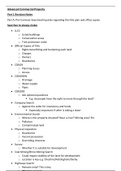Biological research techniques
Biological model organisms ..................................................................................................................... 2
Experimental design ................................................................................................................................ 5
Light microscopy ...................................................................................................................................... 6
Electronic microscopy.............................................................................................................................. 8
Spectroscopy ......................................................................................................................................... 12
Electrophoresis ...................................................................................................................................... 19
Proteomics............................................................................................................................................. 20
Chromatography .................................................................................................................................... 22
Ecosystem research ............................................................................................................................... 26
Wildlife monitoring................................................................................................................................ 29
Remote sensing ..................................................................................................................................... 30
Introductie in de regels van wetenschappelijk argumenteren & kritisch denken ................................. 31
,Biological model organisms
The first biological model
Drosophila melanogaster: fruit fly, breeding experiments by Thomas Hunt Morgan.
Eye colour inherited → associated with specific genes.
+ : small, rapid reproduction: short generation time, easy to measure traits, sexual dimorphism, easy
to maintain: simple diet, low ethical and financial burden.
Criteria to be a good biological model
- Genetic tractability: well-characterized genome → easily manipulated and studied
- Short generation time: study multiple generations
- High reproduction rate: facilitates statistical analyses
- Small size: simplifies housing and maintenance
- Ease of cultivation: reduce cost
- Clear developmental stages → study embryogenesis
- Conservation of biological mechanisms → provide insights into fundamental biological processes
applicable across different species.
- Availability of tools and resources: established protocols
E.coli
→ Bacteria → enterobacterales (lives in gut: harmless, digestion)
→ Diet: gut content (fermenter)
First organisms to have genome (small and circular) sequenced, quick and easy to grow.
Biotechnology workhorse: rapidly produce large amounts of protein: insulin or enzyme production,
recombinant proteins, vaccine antigens.
Bioindicator for water quality: fecal contamination.
Evolutionary model: long-term evolution experiment (LTEE) → parallel evolution. Experimental
evolution of antibiotic resistance → mutations in specific genes of horizontal gene transfer. Evolution
of cooperation and altruism: self-sacrifice.
Synthetic biology (Toggle switch): creating an organism from scratch, stable states under same
conditions → detecting switch from state 1 to state 2: synthetic memory → 2 promotors that inhibit
each other’s activity.
Gene regulation: LAC operon, induce expression of necessary genes for lactose metabolism →
adaptation.
Yeast (Saccharomyces cereviviae)
→ looks like bacteria → Eukaryota → fungi → Ascomycetes
→ Habitat: on surfaces of plant tissue
→ Diet: fresh organic matter (sugars)
Model in cell cycle regulation: yeast easy to manipulate → cyclins ( = proteins that oscillate in
concentration throughout cell cycle, bind to CDKs to activate them at specific points in cycle), cell
cycle checkpoints (critical points where regulatory proteins assess whether cell proceeds to next
phase), ubiquitin-mediated protein degradation (proteins are tagged with ubiquitin molecules and
subsequently degraded by proteasome), tumor suppression and cancer.
Slime (Dictyostelium discoideum)
→ myxomycetes, makes fruiting bodies (“small mushroom”).
→ Habitat: forest floors, decaying leaves, rotten logs (damp and organic)
→ Diet: bacteria
Individual amoeba-like cells live independently → in scarcity cells aggregate to form “slug”: moves
, towards light and heat (chemotaxis), forms fruiting body with stalk and spore-containing structure.
Chemical signalling: cAMP gradient → signal for cells to move towards higher concentrations when
food becomes scarce.
Cell motility and chemotaxis: cAMP directed movement → cells move in response to gradients of
signalling molecules.
Cell differentiation and developmental transitions: stalk cells at base of slug undergo programmed
cell death do sporocarp raises above ground.
Phagocytosis and immune responses: phagocytic organism → engulfing bacteria: builds immunity.
Aggregation and collective movement: chemotaxis through cAMP gradient, cell-cell adhesion
molecules facilitate contact between cells and intracellular pathways activate upon contact =
behaviour changes → synchronized cell movement and differentiation.
Roundworm (Caenorhabditis elegans)
→ Nematoda
→ Habitat: decaying organic matter like soil, compost.
→ Diet: bacteria and other microorganisms.
Good model: simple nervous system and transparent body → studying neuronal development.
RNA interference (RNAi): injecting dsRNA in cells to study gene function.
Apoptosis: fixed pattern of cell divisions → cell dead is normal and tightly regulated, cancer research.
Aging and longevity: resveratrol in wine → extends lifespan + enhances stress resistance.
Stress tolerance: conserved stress-responsive pathways like heat shock factors (HSF), pathogen
responses: toll-like receptor pathway, autophagy and apoptosis, nutrient-sensing pathways like
insulin/insulin-like growth factor (IGF).
Fruit fly (Drosophila melanogaster)
→ Arthropoda → Diptera
→ Habitat: rotting fruits.
Model for genetics, developmental biology, and behaviour → genetic linkage and recombination,
homeotic genes, memory and circadian rhythm genes.
Zebrafish (Danio rerio)
→ Chordata
→ Habitat: South Asia: freshwater with vegetation (rice paddies, slow rivers).
→ Diet: aquatic invertebrates, zooplankton.
Good model: transparent embryos
Developmental biology and embryogenesis: organ formation, organogenesis and disease.
Tissue repair and regeneration: regeneration of heart muscle and fins → implications for regenerative
medicine and cardiology.
Cancer research: basis of tumour development, metastasis and drug responses.
Metabolism and obesity: lipid accumulation visible in live animals.
Nanotechnology and drug delivery: delivery and toxicity of nanoparticles and drug compounds.
Drug discovery and development: high throughput bioassays.
Studying diabetes: different from rodents → induce diabetes from immersion in high glucose water,
easier to handle, less ethical issues, fluorescence imaging possible of whole organism.
House mouse (Mus musculus)
→ Chordata → mammalia
→ Habitat: grasslands and forests to urban and agricultural areas.
Highly adaptable, association with humans → colonization.
→Diet: omnivorous.













